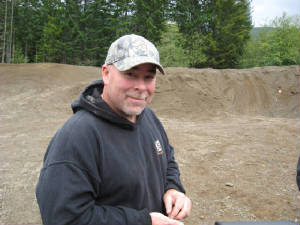Senator Proposes Bigfoot License Plates
A senator is pushing for a specialty license plate commemorating bigfoot. Who wouldn't want one of those?
There are hundreds of specialty license plates out there. They honor colleges, sports teams, cultural groups and hobbies. They often raise money for worthy causes.
Pretty soon, Washington state might offer the coolest specialty tag of them all.
Earlier this month, state Sen. Ann Rivers of La Center, Wash., proposed a license plate depicting Sasquatch that Washingtonians could proudly display on their cars and trucks. A plate featuring the legendary furball would cost $40, according to the Everett Herald, $28 of which would be used to support the Evergreen State's parks.
For more, click here.




Hahahahaha ikdummy got completely destroyed today. Never could answer the timeline problem with the PG film.
ReplyDeleteThe delusions have completely taken over huh Stu? Somebody get the net and the dart gun, he's gotta go back to the ward.
DeleteAll I saw way you getting annihilated by Iktomi for 2 days straight. I enjoyed reading it very much.
*Was*
DeleteGREAT NEWS! ED CAN BE CURED!
DeleteWe are gonna teach you how to start fixing your personal life! it has never been this easy! With our innovative anti-impotence tablets, it works by thwarting the aging process!
Follow the URL to read precise info!
http://www.denverfamilydental.com/vwsg06/editors_groups_lista.php?am9rZXJqZXdlaUBhb2wuY29t
Hey Stuey! Just a recap... There is nothing in the timeline to challenge. To challenge something in adult debate (not that debate ever occurred today), one would need facts to challenge. Assumptions and conjecture that the timeline somehow finds a magic monkey suit that defies 50 years of SFX, doesn’t find a magic monkey suit. Not only that, but if you had simply continued reading your own JREF source, you’d have known that both claims don’t stand...
DeleteMaxs, if it was shot Friday around 1:30, and shown late Sunday morning, the story I have always heard, how is that 12 hours?
DeleteI don't recall a Saturday showing.
Murphy's account allows a Saturday showing, as the film is finished processing, but reports only a Sunday showing.
Quote:
Al De Atley picked-up the film at the Seattle airport on the morning of Saturday, October 21, 1967. He had the film processed at the Alpha Cine laboratory in Seattle and returned to his home in Yakima that same day. Patterson and Gimlin arrived at Yakima sometime on Sunday morning, October 22, 1967. During this time, John Green arrived at De Atley's home and the two men awaited Patterson's arrival. When Patterson arrived, De Atley took him alone to the basement of his home and showed him the film. The film was then shown to John Green. Bob Gimlin was not present. We are told he was at home resting.
Your source goes back and forth with mere hearsay, “he said, she said” soap opera BS that I’d be embarrassed to use, especially since you have an SFX defying “monkey suit” that needs to be addressed... If you think religious zealots like you get around that with mere conjecture, you lose.
Delete“Processing Kodachrome film, (from Dwayne's Photo, the last film lab in the USA to actually process Kodachrome:
"Here is some information from our V.P. of Operations:
I don’t know for Kodachrome II - that was the K-12 process. But for the more modern K-14 process the “Dry to Dry Time” – from when the film goes onto the processor to when it takes up after the dryer is about 50 minutes. I doubt it was a lot different for K-12 and it certainly would not have been more than 15 minutes different either way. He also needs to understand that how long the entire film takes to process depends on how many total feet of film there are to process. The answer above is for a given piece (you could think of it as a given foot) of film. That time is fixed by the type of film process (in this case Kodachrome) and does not change based on the speed of the individual film processing equipment. If there are thousands of feet of film to run then how long it takes the entire film to be processed is governed by how fast the processor runs. For example, if the processor runs at 50 feet per minute and you have 5,000 feet of film to develop it will take 100 minutes to feed the entire 5,000 feet of film into the processor and 150 minutes for it all to take up at the dryer.
If this is confusing – I’ll be happy to talk to the customer and explain it.
Grant Steinle"
As usual, the members of this forum are just spouting false facts, like a claim it takes 36 hours to process Kodachrome film.
- Bill”
Now wonder fundies like you hate the Munns Report.